This week on the Naked Scientists we're taking the ultimate road trip - following the spread of humans across the globe. We're joined by Jenny Collier to discuss how an enormous flood cut Britain off from Europe, sparking thousands of years of jokes and grudges in the process.& Chris Turney will be here to explain how you date a Hobbit, using radiocarbon rather than romantic means. We'll also be looking at the history of fire, discussing recent evidence that early man could have kept his toes warm at the hearth 1.5 million years ago.& Meanwhile here in the present day, Kitchen Scientists Ben and Dave have a go at making fire the old-fashioned way.
In this episode
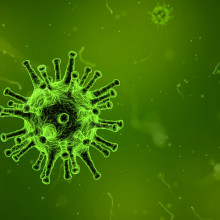
02:00 - Viruses vanquished with a burst from a laser
Viruses vanquished with a burst from a laser
Scientists in the US have developed a laser technique to selectively wipe out viruses and bacteria whilst leaving human cells unharmed...
The approach could be used to improve the safety of blood transfusions and other blood-derived products butwithout the risk of harming the cells present.
Kong-Thon Tsen and his colleagues at Arizona State University made the discovery when they exposed solutions of viruses, including bacteriophages and TMV, a plant virus, to a train of very short (femtosecond duration) bursts from a near infrared (850nm) laser. After an hour, the viruses were completely inactivated.
The team then repeated the experiment using E. coli bacteria and, again, after one hour, the bacteria were all destroyed. But when they exposed solutions of human cells to the same treatment, the cells remained viable and healthy.
The researchers think that the laser pulses rip apart the outer coats of the microbes in the same way that it's possible to smash a glass with sound waves. The bursts of laser light cause a phenomenon called impulsive stimulated Raman scattering (ISRS), which sets up patterns of lethal vibrations amongst the proteins on the outsides of the micro-organisms, breaking them open.
But mammalian cells, possibly because they are much larger, require between 20 and 100 times more energy to trigger the same process, so they're relatively invulnerable to the effect.
As a result the team are confident that the technique, which should also be immune to bugs becoming resistant to its effects, could play a major role in the clinical setting.
"Although it is not clear at the moment why there is a large difference in laser intensity for inactivation between human cells and micro-organisms such as bacteria and viruses, the research so far suggests that ISRS will be ready for use in disinfection and could provide treatments against the worst, often drug-resistant, bacterial and viral pathogens," says Tsen.
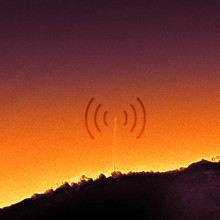
Tuning in to Nano FM
Never mind the Nano iPod, a team of researchers at the University of California at Berkeley have built a working radio made from a single carbon nanotube.
 By fixing the tube between two electrodes, it can fulfil all the functions of a radio - acting as an antenna, tuner, amplifier and demodulator. The team showed that their nano radio could tune into a radio signal generated in the room, and play it back through an attached speaker. In fact, the first song that was broadcast to the radio was "Layla" by Derek and the Dominos, ironically followed by "Good Vibrations" by the Beach Boys.
By fixing the tube between two electrodes, it can fulfil all the functions of a radio - acting as an antenna, tuner, amplifier and demodulator. The team showed that their nano radio could tune into a radio signal generated in the room, and play it back through an attached speaker. In fact, the first song that was broadcast to the radio was "Layla" by Derek and the Dominos, ironically followed by "Good Vibrations" by the Beach Boys.
But how does it work? When a radio wave passes across the nanotube, it causes a change in the electrons that are streaming along it, and causes the tube to vibrate. This is the action that effectively "decodes" the radio signal, and transmits the information.
And by lengthening or shortening the nanotube, the researchers were able to control the frequency of the radio signal that the device could receive. Using this technique, the researchers could make the radio work across frequencies that are usually used for commercial radio stations.
 But aside from the novelty value, the technology could be used for many different applications. For example, it could be used in radio-controlled devices that could travel in the human bloodstream or microscopic mobile phone devices. In the long term, the researchers are hoping to develop miniature sensors that can communicate wirelessly.
But aside from the novelty value, the technology could be used for many different applications. For example, it could be used in radio-controlled devices that could travel in the human bloodstream or microscopic mobile phone devices. In the long term, the researchers are hoping to develop miniature sensors that can communicate wirelessly.
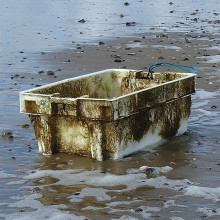
Plastic poisons worming their way up the food chain
Researchers at Plymouth University in the UK have uncovered worrying evidence of how, thanks to plastic  waste in the sea, organic poisons make their way up the seafood chain and ultimately into us. Scientists have known for some time that plastic washed into the sea breaks up into tiny particles, called microplastics, which can absorb oil-based pollutants such as PCBs, nonylphenol and DDT, which are present at low levels in the water. They also suspected that when these particles settle on the seafloor, sediment dwellers like marine worms would ingest them and concentrate their chemical cargo of organic pollutants. Then, when the worms fell victim to predators such as fish and crabs, the chemicals they contained would pass up the food chain. Now Emma Teuten and her colleagues have proved that this is indeed the case. Writing in Environmental Science and Technology, the researchers tested the effects of adding small quantities of plastic mixed with the organic pollutant phenanthrene to tanks containing sediments inhabited by lugworms (Arenicola marina). Compared with control worms, these plastic-exposed animals were predicted to be carrying 80% higher tissue concentrations of the pollutant. "It [plastic] accelerates the mechanism by which contaminants accumulate in the food chain," says Teuten. The team suggest that more research is needed to understand the implications of their findings, including looking at other types of plastics, and how they affect the persistence of pollutants in the environment.
waste in the sea, organic poisons make their way up the seafood chain and ultimately into us. Scientists have known for some time that plastic washed into the sea breaks up into tiny particles, called microplastics, which can absorb oil-based pollutants such as PCBs, nonylphenol and DDT, which are present at low levels in the water. They also suspected that when these particles settle on the seafloor, sediment dwellers like marine worms would ingest them and concentrate their chemical cargo of organic pollutants. Then, when the worms fell victim to predators such as fish and crabs, the chemicals they contained would pass up the food chain. Now Emma Teuten and her colleagues have proved that this is indeed the case. Writing in Environmental Science and Technology, the researchers tested the effects of adding small quantities of plastic mixed with the organic pollutant phenanthrene to tanks containing sediments inhabited by lugworms (Arenicola marina). Compared with control worms, these plastic-exposed animals were predicted to be carrying 80% higher tissue concentrations of the pollutant. "It [plastic] accelerates the mechanism by which contaminants accumulate in the food chain," says Teuten. The team suggest that more research is needed to understand the implications of their findings, including looking at other types of plastics, and how they affect the persistence of pollutants in the environment.
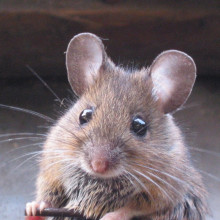
Making mighty mouse
Researchers at Case Western Reserve University in Ohio have managed to breed some "mighty mice", capable of running at top (mouse) speed on a treadmill for up to six hours without stopping.
 These impressive wee beasties have been genetically engineered to have unusually high levels of an enzyme called PEPCK-C in their muscles. This enzyme is normally involved in glucose metabolism, and helps our bodies to make energy from sources such as glycogen and fat.
These impressive wee beasties have been genetically engineered to have unusually high levels of an enzyme called PEPCK-C in their muscles. This enzyme is normally involved in glucose metabolism, and helps our bodies to make energy from sources such as glycogen and fat.
The researchers found that the mice eat 60 percent more than usual, but remain fitter, trimmer and live and breed longer than their normal counterparts. The mice were also tested on treadmills, and the scientists found that the modified ones could run for nearly twice as long as unmodified mice.
Lead researcher Richard Hanson compared the metabolisms of the mighty mice to cycling ace Lance Armstrong biking up the Pyrenees. He points out that these mice use mainly fat, rather than sugar, for energy, and produce very little lactic acid compared to normal animals. It's the lactic acid build-up in muscles that causes pains and cramps after intensive exercise.
The mice were bred as part of an on-going research project aimed at understanding the role of the PEPCK-C enzyme in muscle and fat tissue, and according to the researchers, they could tell from the start that these mice were a bit special, and apparently they ran continuously in their cages from an early age. But as well as being more active and virile, they're also more aggressive.
The scientists found that these traits continued for at least two years - that's considered old age in mouse terms. Some of the female mice were even having babies at the ripe old age of 2 and a half years, which is very unusual - as most don't breed after they're about a year old.
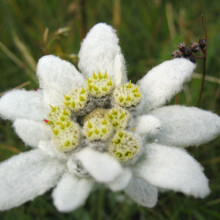
Edelweiss, music to the ears when it comes to sunscreen
 Researchers studying the high Alpine plant edelweiss may have stumbled on an impressive new sunscreen strategy. Brussels-based researcher Jean Pol Vigneron and his colleagues wondered how the eledweiss plant was able to withstand so effectively the high doses of UV radiation that accompany life at high altitude. To find out they measured how the plant absorbed or reflected lights of different wavelengths, expecting to see the UV being bounced back at them. But they were shocked to see that whilst most wavelengths were reflected, UV wasn't. "It's astonishing, but the plant completely absorbs the UV," says Vigneron. Edelweiss leaves are covered in fine white hairs and the team wondered whether they might be responsible for soaking up the UV. To find out they studied them under the electron microscope, which revealed that the hairs are made up of tiny fibres, each just 176 nanometres (millionths of a millimetre) across. This diameter means that the fibres are about the same size as the wavelength of ultraviolet light, and can interact with it. The researchers think that the tiny strands steer the UV away from the leaf where it could do harm and into the middle of the hair where it can be soaked up by a material in the centre, possibly purewater, which is a good absorber of UV. Vigneron suspects that the same trick could also work for sun-lovers seeking better protection than that offered by standard titanium-based creams and lotions currently on the market.
Researchers studying the high Alpine plant edelweiss may have stumbled on an impressive new sunscreen strategy. Brussels-based researcher Jean Pol Vigneron and his colleagues wondered how the eledweiss plant was able to withstand so effectively the high doses of UV radiation that accompany life at high altitude. To find out they measured how the plant absorbed or reflected lights of different wavelengths, expecting to see the UV being bounced back at them. But they were shocked to see that whilst most wavelengths were reflected, UV wasn't. "It's astonishing, but the plant completely absorbs the UV," says Vigneron. Edelweiss leaves are covered in fine white hairs and the team wondered whether they might be responsible for soaking up the UV. To find out they studied them under the electron microscope, which revealed that the hairs are made up of tiny fibres, each just 176 nanometres (millionths of a millimetre) across. This diameter means that the fibres are about the same size as the wavelength of ultraviolet light, and can interact with it. The researchers think that the tiny strands steer the UV away from the leaf where it could do harm and into the middle of the hair where it can be soaked up by a material in the centre, possibly purewater, which is a good absorber of UV. Vigneron suspects that the same trick could also work for sun-lovers seeking better protection than that offered by standard titanium-based creams and lotions currently on the market.
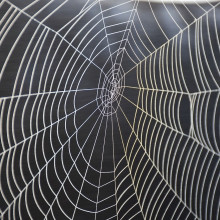
Are spiders' webs edible?
Chris Smith untangled this sticky question...
Spiders do eat their webs. The web material is protein, so spiders do consume them them, sometimes every day, to recover some of the energy they've expended on building them in the first place.
Another interesting use of spider webs is that they've got quite a lot of a vitamin K in them, which can help your blood to clot; and before the use of gauze, people used to put spider webs on wounds!
People are currently looking into what makes spider webs so strong, with the hope of making the material artificially: spiders' webs would make great bullet-proof vests.
They've found the proteins in them that make them strong, called Spidroin 1 and Spidroin 2, and you can produce these in the lab. But they have to use insect cells to grow it, because the insect cells do some chemical modification and insects are more closely related to spiders.
They're not at the point where you can scale it up to a bullet-proof vest yet, but it's certainly interesting!
Why do we get wrinkles?
It's probably because your skin's regenerating as you have cells in the top layer of your skin or epidermis that are constantly multiplying to replace the skin that dies but the bit that holds the structure of your skin at a lower level is called the dermis and that contains a molecule called elastin which breaks down as you get older. You also lose the fat in the lower layers of your skin. So although the top layer of your skin is regenerating it's the bottom layer that's going saggy and makes you wrinkly. And if you smoke, the chemicals in cigarette smoke also encourage that break-down to accelerate which is why people tend to get a lot of wrinkles around their mouth if they smoke. A good way to anti-age yourself is to stop smoking and stop going on sunbeds as well.
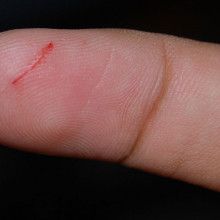
Why is it recommended to put salt on cuts?
A lot of bacteria, especially the ones in the mouth like Streptococci and some of the other mouth-dwelling organisms, are quite salt-sensitive.
For them, a big dose of salt is a bit like putting salt on a slug. It pulls the water out of the bacteria and dehydrates them, which can damage or disable them.
But some other bacteria, like Staphylococcus aureus, actually like salt; so if you have a wound on your finger it might not actually be so good for that because it will kill the bugs in there which are not Staphs, removing the competition for Staphylococci that are there; so you might end up with your wound being colonised entirely by Staph!
Overall, salt is quite good in very high concentrations because it stops a range of bugs growing, which is why meats and produce are salted to preserve them. But, the likelihood of you getting enough concentration of salt into a wound to kill the bugs is quite unlikely. It does have a soothing effect though, especially on mouth ulcers!
[This topic - on rubbing salt into a wound - has also been discussed on the Naked Scientists science forum]
Why do your arms lift after pushing out for a while?
This is to do with the way in which your muscles control their length because hidden inside each of our muscles is a tiny thing called a muscle spindle and this is like a miniature muscle which has nerve fibres in it and those nerve fibres can tell how much the muscle is being stretched or lengthened. When you put force through a muscle it's trying to register, 'how hard should I contract, am I contracting at the right rate?' If the muscle is contacting hard but not going anywhere then this spindle doesn't stretch and it keeps sending messages back to the muscle saying you're not getting any longer, work harder. So when you're pushing up against the wall and your arm isn't going anywhere , it's trying to contract harder and harder to move the wall which, of course, doesn't move. Then when you move away from the wall and you switch off the voluntary drive to the muscle the spindle is still set to say I'm too short, I need to be longer. It tells your nervous system automatically like a reflex to make your arms longer.

Why moving air feels colder than still air?
This is the wind chill factor and the answer to this is a bit like saying 'I'll turn the fan on.' Does it make a room colder? No! A fan running does not cool a room. A running fan keeps the room at the same temperature, it just moves more air past you. Air molecules, when they run past you, if you're sweating and hot, each molecule can take a little bit of heat away from your skin so the more molecules that pass your skin the more heat you can lose. It makes you feel cooler but it doesn't actually affect the temperature and that's why when you're driving along nice and fast with your window down, lots of air molecules running over you cools you down.
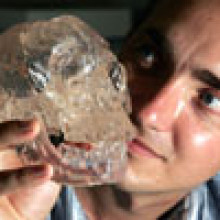
Dating the Hobbit
with Professor Chris Turney, University of Exeter
Chris - Welcome to the Naked Scientists. Your work has largely been very exciting because you got to do things like date these hobbit people that were discovered a few years back but probably a lot of people are wondering where does man come from and could you possibly set the scene for us? Tell us what the time line is for the evolution of people on Earth and where we all came from?
Chris Turney - Yeah sure, Chris. Essentially the earliest remains of humans are in Africa about 2.5-2.3 million years ago. That's a species called Homo habilis or 'handy man.' Apologies for the remarkably sexist names actually, it's always man! But anyway, Homo habilis was the first species of our genus. After that it all gets a bit hazy. Traditionally it was always thought that an offshoot of that was Homo erectus (erect man). And the traditional view was that Homo erectus at some point migrated out of Africa and settled across different parts of the world: in Asia - Peking Man; Java Man down in Indonesia. In Europe he eventually evolved into Neanderthals. That was the traditional view and that's the called the 'Multiregional' hypothesis which essentially is that these different species around the world evolved into us: Homo sapiens with a little bit of romantic liaisons on the edge. I wouldn't say that's the widely accepted view now but the more accepted view is the 'Out of Africa' hypothesis which is that our species (of which the earliest evidence is from about 200,000 years ago) evolved in Africa and then migrated out of Africa somewhere between 50,000 years to 100,000 years ago. They moved out across the world and essentially displaced all these ancient species of human.
Chris - Why do we think that that's the case? Why have we changed our view that rather than evolving in-situ they actually had to come out of Africa twice?
Chris Turney - Well, there's always evolution going on around the world all the time but essentially the species, our species, looks like the earliest evidence in Africa and nothing broadly comparable. I guess really, and we'll come to that again, but the hobbit is also evidence of 'Out of Africa.'
Chris - How do we know about that magic date of 50,000 years ago? What's the evidence for that?
Chris Turney - Well, really it's constrained really. We've got evidence of modern humans in Europe around 40,000 years ago (55-40,000ya). Really the lynchpin is essentially Australia actually. There's not a lot of evidence of modern humans between Africa and Australia. There's lots of stone tools but there's very little modern human remains. There's a little bit in Borneo and essentially it's in Australia. Australia opens up all sorts of interesting angles because essentially even during an ice age when the sea level drops 120m, it's always been an island. So people must have actually built boats to get across so the early stages therefore were 50-60,000 years ago.
Chris - So people were building boats 50,000 years ago? That's really something isn't it?
Chris Turney - Well, that's right, We've got no direct evidence of it and, of course the alternative is a pregnant woman on a mat of vegetation or an elephant swimming across with people on him but I think basically a boats is probably a more likely one.
Chris - So tell us about the colonisation of Australia because that in itself's an interesting story. Because people didn't know exactly when the first settlers arrived there unless, I guess, you and your various techniques came along?
Chris Turney - Well, it's been an interesting story actually. If you went back to the 1960s the earliest ages based on radio carbon dating were essentially around 10,000 years ago. And over time, gradually, it's been pushed back and pushed back. Until about ten years or nearly 20 years ago now it was about 40,000. There's a limit to radio carbon dating and 40,000 was traditionally quite close to how far back you can detect with that method. Then other methods came along and they started coming up with ages of 50 and 60,000. There was nothing close to that. So my research interest was really seeing if we could push back radio carbon dating and were those ages real artefacts of the method or were they real?
Chris - If we could just explore that a little bit, Chris - why is carbon dating restricted to those dates that you mention? Why can't it go on ad infinitum?
Chris Turney - Well it all comes really down to this quirky concept called the half-life which essentially after a period of time half of your radioactive element disappears. So a radioactive carbon or C14 has a half-life of about 5,500 years. Every 5,500 years you lose half. After about seven or eight half-lives you've essentially got very little left. I guess the thing is if you took a piece of coal which is millions of years old and you added to that carbon 1% of something from your body (modern carbon) you'd come up with an age of 37,000 years if you measured that. That doesn't mean the coal's 37,000 years it's just how far back it can really date.
Chris - How did you crack that nut?
Chris Turney - A combination of things. In Australia and South East Asia, probably lots of places in the world. Early archaeological remains, a lot of the artefacts are found associated with charcoal and charcoal's great as there's lots of it. It's a product of burning. In many environments it can survive for quite a long time. The problem is it soaks up everything in the ground. If you've got smelly feet you can use a bit of charcoal. If it sits in the ground for 40,000 years it can pick up a lot of contamination so the method that we use was to clean up the carbon out of the charcoal and then we had a special vacuum line where we basically heated up the charcoal, burnt off all the contamination and cleaned up the sample for dating.
Chris - What did that show you about Australia?
Chris Turney - Well essentially when we actually tested it out, intriguingly some of the early sites became younger. Some stayed the same age but a few crucial ones actually became quite a bit older. One of them got back to around 52,000 years.
Chris - So that says people were knocking around Australia must have had the capacity to get across the water 50,000 years ago but also, what about the climate then? Obviously Australia's struggling now with not enough rainfall, Murray Darling river's down to a trickle because so much is having to be taken out for irrigation. Was it always like that?
Chris Turney - No. Australia swings backwards and forwards with aridity, all the time. Essentially, this is pretty unusual what's happening at the moment. We've been doing a lot of work out there trying to reconstruct the climate and try and get a better handle on what's happened in the past.
Chris - So what do you think has happened?
Chris Turney - Essentially, I think we're in a lot of trouble unfortunately. We're gonna have to start doing something pretty seriously.
Chris - But if you look at say, the timing of the arrival of people. One of the things that indigenous peoples in Australia have been doing for 40,000 years is burning stuff. So is there any evidence that they have brought about any of the change that you see in Australia?
Chris Turney - Well, some people have argued that. Yes we've done a lot of dating and looking at reconstruction of what vegetation was like and there does seem to be a coincidence between changes in vegetation, at least in NE Australia, and burning. So some people have argued that actually, human arrival caused catastrophic collapse of vegetation and it dried out. Other people disagree with that view. It's an interesting debate going on.
Chris - If we could just turn finally to the hobbit story which was really exciting a few years ago. How do these hobbits, these little people fit into this whole picture of the colonisation of Australia and what else was going around the world at the same time?
Chris Turney - That was great fun. We were basically interested in trying to work out when Homo erectus died out across Indonesia and one of the early sites that we were interested in was led by a colleague, Mike Morewood ate the University of Wollongong. Mike was interested in the island of Flores and working with the Indonesian colleagues. He went back to one of the key sites that had been excavated before and there'd been burials found in the surface and lots of stone tools. Essentially when they were digging down they're looking for Homo erectus. They came across an entirely new species of human, Homo floresiensis.
Kat - There's been various arguments about whether it really is genuinely a new species or not. I've heard people say oh well it's just a pygmy or something like that. How do we know that it is genuinely a new species, an offshoot?
Chris Turney - Well there's quite a lot of evidence now presented in that shape of a skull, the shape of the whole skeleton actually, the pelvis and feet, the wristbones more recently and the brain size as well. Typically, if you look at the history of science as well, whenever a new species of human is discovered there's usually some question about a diseased individual. When the first Neanderthal was found someone claimed it was a giant bear. Another person was a Mongolian Cossack. You've got lots chasing back Napolian in 1840. Another was that it was a child that suffered from rickets, got bashed over the head and a bit of arthritis. So it's par for the course really.
Chris - Just looking briefly at the timeline, Chris. How many years were there hobbit people around on Earth?
Chris Turney - Well, some of their traits are remarkably ancient, possibly 2 million years or so. They certainly arrived in Flores by a million years ago and the most recent evidence we've got is 13,000 but there's some tantalising stories from the locals, Ebu Gogo, the ancestor who eats everything and the locals insist that they arrived in the island just before the Dutch turned up a couple of hundred years ago. Mind-blowingly there might have been another species of human being on the island.
Chris - Thank you very much Chris Turney.
 Chris has also written a book on this subject called Bones, Rocks and Stars: the Science of when things happened. This is currently available in hardback and will be out in paperback on November 13th.
Chris has also written a book on this subject called Bones, Rocks and Stars: the Science of when things happened. This is currently available in hardback and will be out in paperback on November 13th.

Ancestral Fires
with Dr Anne Skinner, Williams College, Massachusetts
Kat - We're no going to speak to Dr Anne Skinner who's from William's College in Massachusetts. Good evening Anne.
Anne - Hello.
Kat - Now, I understand that you've been studying how humans have used fire in history. So can you put it in a bit of context? How far back did we previously think humans have been using fire?
Anne - Prior to the work that I did a few years ago the earliest of dates for fire were about 300,000 years ago. That is, controlled use of fire by human beings.
Kat - So we're talking about camp fires here, basically?
Anne - Yes, yes.
Kat - What have you done now?
Anne - So what I did, about in the 1980s some bones were found in Swartkrans Cave which is in South Africa. They'd clearly been burnt. The layer in which they were found was dated to about 1 and a half million years ago and the question was, 'how did these bones get burnt?' And, 'could that be evidence that they were deliberately burnt as a result of human activity?' So I used a technique that's called electron spin resonance - we won't have to spend a lot of time on that - to look at the remnants of the burning process. If you burn something long enough you get soot. But if you don't burn it quite long enough you have some other organic materials in it. And the actual ones that you find will depend on how hot the fire was.
Kat - So will that be the difference between whether it was a campfire or say, just an accidental bush fire?
Anne - Right. Because at the time it was not a forested area. If it was an accidental fire it would be a grass fire about 300 degrees centigrade maximum. Camp fires go easily up to 500/600 degrees centigrade. So if these bones had been heated well over 300 that would suggest that the fire that had heated them had been deliberately assembled by the people who were also assembling the bones.
Kat - So it was basically a barbecue?
Anne - Not really, there's no sign that they were cooking. This has been billed as the earliest barbecue or as South Africans call it, a braai. First of all, if you actually cook something to 600 degrees centigrade it isn't fit to eat any more.
Chris - I dunno, you've obviously not tried my wife's cooking, Anne.
Anne - Also, you couldn't have counted on having the fire all the time. That is, probably what happened was that there was a lightning strike, some bushes caught of fire and they dragged burning wood back to the cave and used it to protect themselves against the leopards which were around.
Kat - That would suggest that humans were using fire one and a half million years ago. That's quite a dramatic difference from 300,000.
Anne - It is. Oh yes! In some ways it's not that remarkable if you stop to think that 1.8 million years ago some of our other ancestors were as, Chris was saying, migrating up into the Caucasus and I know climate was milder there. But I'm sure they would have appreciated having at least some knowledge of the properties of fire in the winter time in the Caucasus.
Chris - Thank you very much Anne, it's brilliant to hear your work.
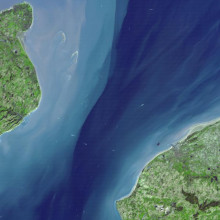
The Big Flood
with Dr Jenny Collier, Imperial College London
Chris - When did Britain become an island in its own right and for a long time that's been a big question but some scientists from Imperial college reckon they solved the puzzle earlier this year. One of them is with us this week and it's Jenny Collier. What do you think happened? How did we become the island that we're very proud of having?
Jenny - Well, it's been something that's been known about from other scientists for some time, particularly people looking at the human occupation of Britain. So we've been hearing a lot about very ancient ancestors of ourselves, humans. But humans first came to Britain about 700,000 years ago (at a very famous site of Boxgrove). Basically during this period, this is the quaternary, so the ice ages were coming backwards and forwards. Living in England was a bit marginal, if you like. Ancient man was coming backwards and forwards. Crossing to France and back into Britain basically as the ice came down and retreated. What the archaeologists have known for some time is that there's a big gap. Basically the humans were coming backwards and forwards for some time and then, for some reason, about 100,000 and 60,000 years ago there's no evidence for any humans at all. What we did in our group at imperial as a group of geologists was to go out and do a marine geophysical study in the English Channel where we literally measured the water depth. We found evidence for a catastrophic, large volume flood, which we think effectively cut Britain off. This helps explain why ancient man couldn't get back in.
 Chris - Two questions, then Jenny, what do you look for on the sea bed that tells you there was a flood? What's the giveaway sort of signature of a flood?
Chris - Two questions, then Jenny, what do you look for on the sea bed that tells you there was a flood? What's the giveaway sort of signature of a flood?
Jenny - What we do in terms of telling a catastrophic flood from a normal fluvial process, as you might imagine, if you've got a very high volume of rapid-discharge water you get all sorts of scours and eddies, a whole group of landforms which you can put together and say they can only be formed by high volume water discharge and that means it's not a fluvial river. Frankly it's enormous. I've been working in a lot of exotic places and I never expected to find something quite so astonishing.
Chris - So a massive flood about, when? 500,000 years ago?
Jenny - Yes, we haven't dated it yet so from a geological point of view the only way we could date it - we call it the smoking guns. We've got the bit that's been carved out. The bit that's been found. We need to go and look towards the edge of the shelf to find out where the sediments that have been carved out had been dumped. We haven't done that yet.
Chris - Where do you think this massive flood came from and what triggered it?
Jenny - Well, that's right. So we've got this great big flood channel and basically it points to the straits if Dover and it's been well known. Again, mainly from people looking at animals and also plants that the straits of Dover was a land bridge that survived throughout these glacial fluctuations so man was happily trotting backwards and forwards across between the England and France across this land bridge which was just a geological structure. We made this hypothesis that the only way to get such a sudden water release would be to have a catastrophic breaching of the rock dam across the straits of Dover which would have releases basically a lake that built up in the southern North Sea.
Chris - And where did that Lake come from?
Jenny - Well as you imagine during a glacial period there's a lot of - we're on the edge of the glacier so there's all sorts of melt water coming from the ice itself. All of the rivers from the northwest of Europe (so for example the Rhine) use to go through the North Sea out into the Atlantic, would all get trapped and build up a big lake which would be dammed behind this straits of Dover rock ridge.
Chris - And that's what cut us off from France and made us country in our own right. Jenny thank you very much.
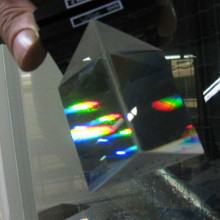
45:05 - Energy of Light?
Energy of Light?
In vacuum and in air, to a greater extent, light is not really interacting with the medium it is in. It's oscillating very fast like a very high frequency radio wave and travelling at its standard speed - the speed of light as we know it. When it enters the glass, the glass contains lots and lots of atoms. Around the atoms are electron clouds. Now, the light when it's in a transparent medium can't excite the electrons, it isn't absorbed, but the electrons do like to try and follow the oscillations of the field. As the electrons are trying to follow the oscillations of the field it means that some of the energy of the light is stored in those electrons. And that whole process, in effect, slows the whole light field down. So the light in the glass is a combination of the electromagnetic wave and the polarisation, as it's called, of the electrons which are travelling together through the glass. This oscillation of the electrons actually gives a rise to this dielectric constant and refractive index. Of course the refractive index is the ratio by which the light is slowed as it travels through the solid material. When the light reaches the end of the solid material, it goes back into air or vacuum and there are no more electrons so the energy that's been stored in the electrons is transferred back into the light field and it speeds up again. Answered by Professor John Rarity.

Why are there apes in the zoo?
Essentially, all of the apes have evolved separately. We separated from chimpanzees somewhere about 5 million years ago and we've all evolved in our own different ways since then. It's quite an interesting question that why are some in the zoo and others aren't and I guess that doesn't say much about us as a species. If we found a hobbit today and put that in the zoo it would be quite an interesting one. But it's not just evolution by anatomy as well. There's research showing that some groups of chimpanzees in Africa have actually developed the use of stone tools several thousand years ago. So there's a stone tool age for chimps.
- Previous Naked Science Q & A Show
- Next Stem Cells and Cloning











Comments
Add a comment